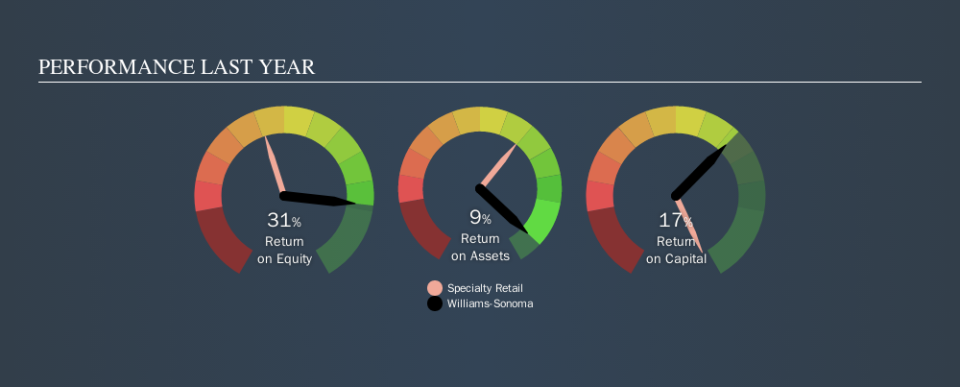Should You Like Williams-Sonoma, Inc.’s (NYSE:WSM) High Return On Capital Employed?

Today we'll look at Williams-Sonoma, Inc. (NYSE:WSM) and reflect on its potential as an investment. Specifically, we'll consider its Return On Capital Employed (ROCE), since that will give us an insight into how efficiently the business can generate profits from the capital it requires.
Firstly, we'll go over how we calculate ROCE. Second, we'll look at its ROCE compared to similar companies. Then we'll determine how its current liabilities are affecting its ROCE.
What is Return On Capital Employed (ROCE)?
ROCE measures the 'return' (pre-tax profit) a company generates from capital employed in its business. All else being equal, a better business will have a higher ROCE. Overall, it is a valuable metric that has its flaws. Author Edwin Whiting says to be careful when comparing the ROCE of different businesses, since 'No two businesses are exactly alike.'
How Do You Calculate Return On Capital Employed?
Analysts use this formula to calculate return on capital employed:
Return on Capital Employed = Earnings Before Interest and Tax (EBIT) ÷ (Total Assets - Current Liabilities)
Or for Williams-Sonoma:
0.17 = US$465m ÷ (US$3.9b - US$1.2b) (Based on the trailing twelve months to August 2019.)
Therefore, Williams-Sonoma has an ROCE of 17%.
See our latest analysis for Williams-Sonoma
Does Williams-Sonoma Have A Good ROCE?
When making comparisons between similar businesses, investors may find ROCE useful. Using our data, we find that Williams-Sonoma's ROCE is meaningfully better than the 10% average in the Specialty Retail industry. We consider this a positive sign, because it suggests it uses capital more efficiently than similar companies. Regardless of where Williams-Sonoma sits next to its industry, its ROCE in absolute terms appears satisfactory, and this company could be worth a closer look.
Williams-Sonoma's current ROCE of 17% is lower than its ROCE in the past, which was 35%, 3 years ago. So investors might consider if it has had issues recently. You can see in the image below how Williams-Sonoma's ROCE compares to its industry. Click to see more on past growth.
It is important to remember that ROCE shows past performance, and is not necessarily predictive. Companies in cyclical industries can be difficult to understand using ROCE, as returns typically look high during boom times, and low during busts. ROCE is only a point-in-time measure. What happens in the future is pretty important for investors, so we have prepared a free report on analyst forecasts for Williams-Sonoma.
Williams-Sonoma's Current Liabilities And Their Impact On Its ROCE
Current liabilities include invoices, such as supplier payments, short-term debt, or a tax bill, that need to be paid within 12 months. Due to the way the ROCE equation works, having large bills due in the near term can make it look as though a company has less capital employed, and thus a higher ROCE than usual. To counteract this, we check if a company has high current liabilities, relative to its total assets.
Williams-Sonoma has total liabilities of US$1.2b and total assets of US$3.9b. As a result, its current liabilities are equal to approximately 31% of its total assets. With this level of current liabilities, Williams-Sonoma's ROCE is boosted somewhat.
The Bottom Line On Williams-Sonoma's ROCE
While its ROCE looks good, it's worth remembering that the current liabilities are making the business look better. There might be better investments than Williams-Sonoma out there, but you will have to work hard to find them . These promising businesses with rapidly growing earnings might be right up your alley.
I will like Williams-Sonoma better if I see some big insider buys. While we wait, check out this free list of growing companies with considerable, recent, insider buying.
We aim to bring you long-term focused research analysis driven by fundamental data. Note that our analysis may not factor in the latest price-sensitive company announcements or qualitative material.
If you spot an error that warrants correction, please contact the editor at editorial-team@simplywallst.com. This article by Simply Wall St is general in nature. It does not constitute a recommendation to buy or sell any stock, and does not take account of your objectives, or your financial situation. Simply Wall St has no position in the stocks mentioned. Thank you for reading.

 Yahoo Finance
Yahoo Finance 
